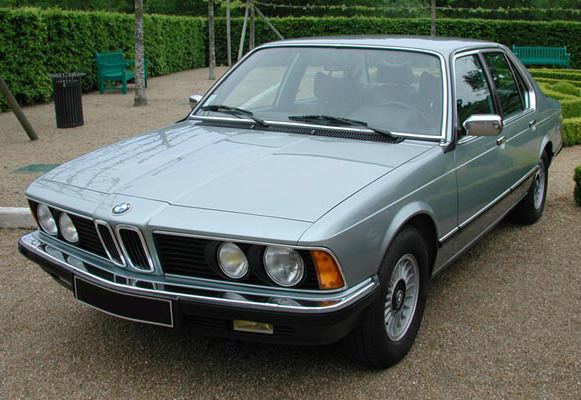Manufacturer BMW Layout FR layout | ||
 | ||
Production 1977–1987285,029 built Designer Paul BracqManfred Rennen (1974) Class Full-size luxury car (F) | ||
The BMW E23 is the first generation of the BMW 7 Series luxury cars, and was produced from 1977 to 1987. It was built in a 4-door sedan body style with 6-cylinder engines, to replacing the BMW E3 sedans. From 1983 to 1986, a turbocharged 6-cylinder engine was available.
Contents
- Engines
- Interior features
- Running changes
- Turbocharged 745i
- South African 745i
- USA and Japanese market models
- Models
- References
In 1986, the E23 was replaced by the E32 7 Series, however the E23 models (called L7) remained on sale in the USA until 1987.
The E23 introduced many electronic features for the first time in a BMW, including an on-board computer, service interval indicator, a "check control panel" (warning lights to indicate system faults to the driver), a dictaphone and complex climate control systems. It was also the first BMW to offer an anti-lock braking system (ABS), a driver's airbag and a new design of front suspension.
Engines
All models were powered by a straight-six petrol engine, with the majority of cars using the M30 engine. Most E23 engines were fuel-injected, however the 728 and 730 models of 1978-1979 used a Solex four-barrel carburetor. The fuel-injected models initially used the Bosch L-Jectronic system, until the 1979 732i, which was the first BMW to use the Bosch Motronic fuel-injection system.
Interior features
Options included leather upholstery, wood trim, power seats, seat heaters, reclining rear seats, power windows, power mirrors, an in-car cellular telephone and rear-armrest radio controls.
Running changes
The 1983 model year facelift (produced from September 1982) included styling changes to the front of the car: the 'kidney' grilles, valance/spoiler, bumper bars, etc. Inside the car, the dashboard and instrument panels were also updated. The rear suspension was updated and the 735i engine changed from the M90 to the M30B34.
In the US, 1984 saw the arrival of the optional 4-speed automatic transmission (replacing the 3-speed unit previously offered), wood trim replacing the plastic above the glove compartment and on the ashtray and electrically adjustable power seats. Michelin TRX tyres (requiring special metric wheels) became available as an option on the 5-speed manual models.
Turbocharged 745i
The 745i was a high-performance model sold in left-hand-drive European markets from 1979-1986. It was initially powered by the M102 engine, which is a turbocharged 3.2 L version of the M30 straight-six engine, producing 188 kW (252 hp) at 9 PSI of boost. In 1982, the engine was upgraded to the M106, which increased the capacity to 3.4 litres and the fuel injection system changed from Jetronic to Motronic. Boost pressure was reduced to 6 PSI, however power output was unchanged.
All cars were built with a 3-speed ZF 3HP22 automatic transmission. Options included heated front and rear power reclining seats, gasoline fired heater, leather covered cellular telephone, rear-armrest radio control, water buffalo hide upholstery, and burl wood trim.
The name 745i comes from the theoretical assumption that turbocharged engine have approximately 1.4 times more power than naturally aspirated engines. By this assumption, a 3.2 litre (3205cc) turbocharged engine would have similar power to a 4.5 litre (4487cc) naturally aspirated engine.
South African 745i
The South African 745i model was powered by the naturally aspirated M88/3 engine, instead of the turbocharged M102/M106 engines of the European 745i. A right-hand-drive version of the turbocharged model was not possible due to the turbocharger being located in the right-hand side of engine bay. Instead, the 745i was fitted with the 213 kW (286 hp) M88/3 engine, as used in the E24 M635i and E28 M5. The engine uses a 24-valve DOHC valvetrain and the fuel injection system is Bosch ML-Jetronic.
A production run of 209 South African 745i was built from 1983 to 1987, 192 of which were with an automatic gearbox and 17 with a 5-speed manual gearbox.
BMW South Africa entered one of these 745i models in Class A of the South African Modified Saloon Car Championship, the only BMW-Sanctioned motor sport application in the history of BMW 7-series cars.
USA and Japanese market models
Only the 733i, 735i, and L7 models were sold in the USA and Japan. These markets also received only upscale versions, usually including leather upholstery, cruise control, wood trim, power windows, power sunroof, and other options as standard.
North American versions were fitted with larger bumpers (to comply with the U.S. National Highway Traffic Safety Administration (NHTSA) standards), smaller sealed beam headlights, and various forms of emissions equipment that were not found on European-market cars. The engines used in these markets had lower-compression pistons and thus were less powerful than European-market versions. Some features such as ABS were available in markets outside North America before they were fitted on American models.
The L7 was a more luxurious version of the 735i for the American market only. It featured special leather upholstery with leather dashboard and door padding (rather than wood trim), a power glass Moonroof. and a variety of optional features as standard. All L7 models were built with automatic transmissions and a standard driver's air bag.
Models
The following models were produced in the E23 generation:
